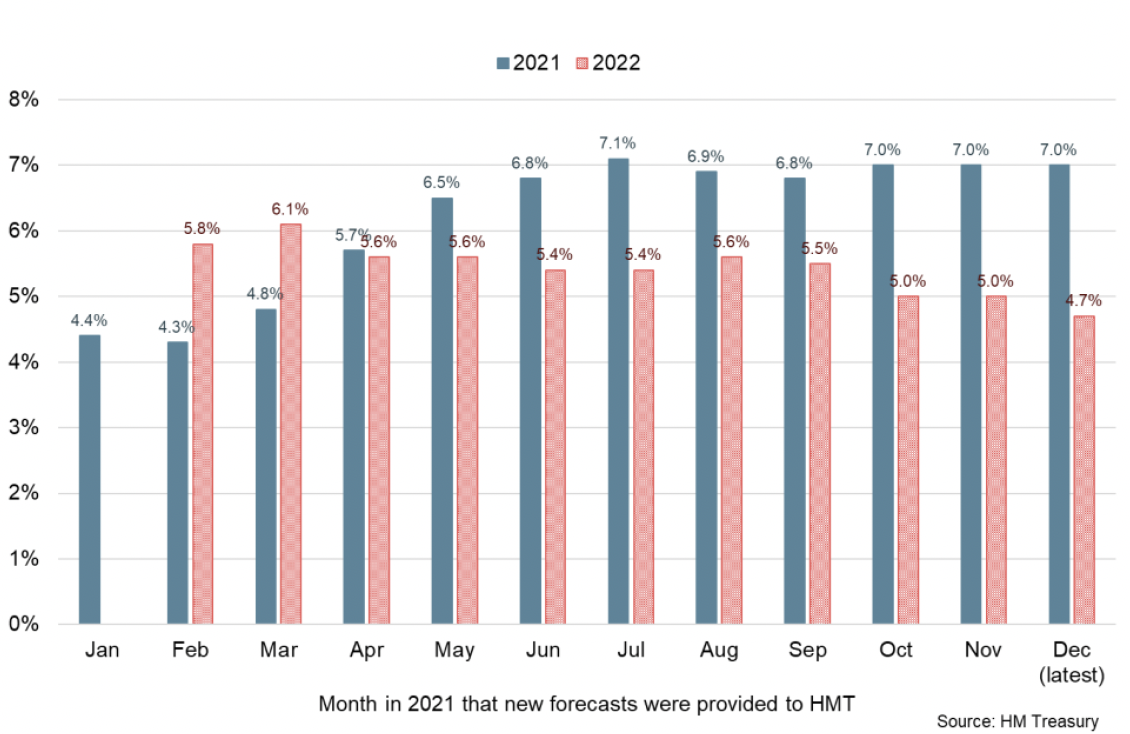Monthly economic brief: December 2021
The monthly economic brief provides a summary of latest key economic statistics, forecasts and analysis on the Scottish economy.
This document is part of a collection
GDP growth outlook
Scottish economic output is forecast to return to pre-pandemic levels in 2022, however Omicron presents a new phase of downside risks and uncertainty.
- In September, Scotland's GDP recovered to 1.1% below its pre-pandemic level and is forecast to return to its pre-pandemic level in the first half of 2022.
- The most recent Scottish Fiscal Commission (SFC) forecasts from December expect the economy to grow 6.7% in 2021 before moderating to 3.8% in 2022 and 1.3% in 2023, and return to its pre-pandemic level in Q2 2022. Longer term COVID related scarring to GDP in 2025 is estimated at 2%. Unemployment is expected to peak at 4.9% in Q4 2021, reflecting some post-furlough job losses and some people who had stopped looking for work, re-joining the labour market.[27]
- More recently, the Fraser of Allander Institute 2021 Q4 Economic Commentary forecasts Scottish GDP growth of 6.4% in 2021 and 4.7% in 2022 with the economy expected to return to pre-pandemic levels in May 2022.[28]
- However, in both cases, the forecasts reflect on the uncertainty and downside risks to the outlook that Omicron presents; the extent to which will only start to emerge at a sector and aggregate level over the coming weeks as more information and data emerge.
- At a UK level, in November, the Bank of England revised down their UK GDP growth forecasts to 7% in 2021 and 5% 2022 (down from 7.25% and 6% respectively in August) reflecting the indicators of slower growth in the third quarter of the year. At their latest MPC meeting in December, they further revised down their expectations for UK GDP in 2021 Q4 by 0.5%, leaving it 1.5% below its pre-pandemic level, reflecting that the persistence of supply chain disruption alongside the emergence of Omicron and the additional COVID measures introduced will place downward pressure on GDP over the turn over the year. Reflecting the strength in labour market data following the end of the furlough scheme, they assume UK unemployment will fall to around 4% in 2021 Q4, compared with the 4.5% projected in the November report.[29],[30]
- The average of new independent forecasts (published monthly by HMT) in December forecast UK GDP growth of 7.0% in 2021 (this has remained stable since October) while the growth outlook for 2022 has fallen further to 4.7%.[31]

- At a global level, in October, the IMF forecast global GDP to grow 5.9% in 2021, easing to 4.9% in 2022.[32] More recently in December, the OECD forecast the world economy to grow by 5.6% in 2021, 4.5% in 2022 and moderate to 3.2% in 2023, setting out that the economic recovery is progressing, but uncertainty remains high and imbalances continue to emerge.[33]
- The pace and stage of recovery varies significantly across countries with the emergence of bottlenecks in global supply chains and a sharp rise in inflationary pressures weighing on the pace of recovery in recent months. The emergence of Omicron presents further significant uncertainty and risks to these imbalances and the pace of recovery.
Contact
Email: OCEABusiness@gov.scot
There is a problem
Thanks for your feedback